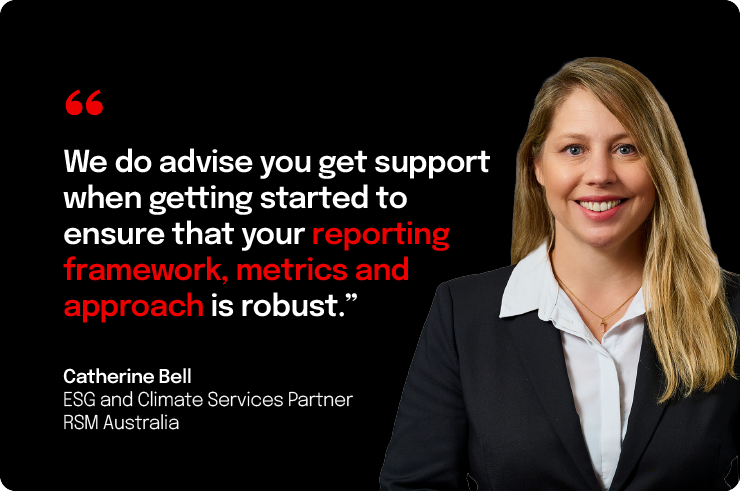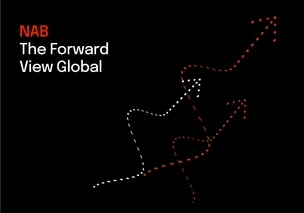16 July 2025
April 16, 2024
Countdown to climate risk reporting
Mandatory climate disclosures are on the way for thousands of businesses and organisations in Australia, with a start date as early as next year planned for the largest corporates. NAB unpacks what’s on the horizon.
By Corporate and Institutional Banking

Businesses can learn from existing climate frameworks and use available data to kickstart responses to the fast-approaching reality of mandatory climate disclosures in Australia, a recent NAB discussion has heard.
Under planned changes to the Corporations Act, Australia’s largest corporates and institutions will need to include climate-related information alongside their financial reporting, starting as soon as January 2025.
The upcoming regulation aims to strengthen the financial system and encourage further economic opportunities for the transition by providing greater clarity and consistency for investors1.
While acknowledging the difficulties inherent in such an evolving space, climate finance specialists stress the time for action is now rather than waiting for perfect data and conditions, with all directors set to be responsible for sustainability going ahead.
“Just start, absolutely,” says RSM Australia’s ESG and Climate Services Partner Catherine Bell. “The measuring, managing and reporting of climate risk – and more broadly the ESG sustainability topics – is intended to focus organisations on business transformation towards sustainable and equitable business practices. It’s becoming a business imperative, particularly for organisations trading globally, as the new business norm.”
Bell was speaking with NAB Executive, Corporate Finance, Connie Sokaris in a discussion facilitated by NAB Global Head of Sustainability David Jenkins and hosted by NAB Head of Sustainability, Client Coverage, Leanne Bloch-Jorgensen.
Bell says the climate reporting principles closely align with those of global financial reporting, which means disclosing information that is consistent, comparable and provided on a reasonable basis, with clear focus on materiality.
“The requirement is essentially to provide informed assessment of the operations, financial position, business strategies and prospects for future financial years,” she says. “It’s based on data and also financial impact.”
Phased approach
Under the changes, large listed and private corporates and institutions which trigger two out of three conditions relating to size and turnover will need to start reporting against new sustainability standards, developed and maintained by the Australian Accounting Standards Board (AASB).
The largest entities (group one) which satisfy conditions of 500 or more employees, $500 million or more in consolidated revenue, and/or $1 billion or more in consolidated gross assets will start reporting from 2025, with other large corporates (groups two and three) to follow in 2026 and 2027. This reporting timeline gives a six-month reprieve from the original start date of July this year.
Bell says companies will need to report their climate-related information under the pillars of governance, strategy, risk management, metrics and targets. This means assessing material issues within the business to construct appropriate reporting frameworks and processes for ongoing data collection and improvement, she says.
Priority disclosures will be Scope 1 and 2 emissions, with other sustainability-related reporting to be included where there is a material risk. By the second year of reporting, Scope 3 value chain emissions will also be required.
Including Scope 3 means the changes will ultimately impact businesses and markets across the whole economy in a “supply chain domino effect”, Bell says.
“Companies are going to be redirecting their strategies towards low-carbon, sustainable suppliers, products and services, so we’re going to see a lot of movement in that space,” she says.
Scenario analysis forms part of the legislation, involving a complex process to test climate risks against at least two possible futures. The standards are also designed to be flexible and scale over time to include reporting on evolving risks like nature and biodiversity.
Taking the first step
Bell says a basic starting point is building knowledge, so organisations can formally understand what is involved in climate change, risk and adaptation, as well as unpacking best sustainable business practices around environment, social and governance issues.
Australia’s mandatory disclosure regime aims to align with the International Sustainability Standards Board (ISSB) as it consolidates myriad global frameworks and builds on earlier work by the Taskforce for Climate-related Disclosures (TCFD).

As such, Bell says the ISSB’s International Financial Reporting Standards (IFRS) for climate and sustainability and the TCFD frameworks are all good reference points for companies starting out.
Data remains a challenge, she says, but should not be reason for delay. In cases where the data is not fully available or not in a usable format, it may be estimated from other information – kilometres driven by a vehicle instead of fuel usage for example. There is also acknowledgment that it will take time to put in place the skills and capabilities needed for data gathering and modelling, with some reporting relief built into the amendments.
For organisations operating across borders, there remains the challenge of developing a framework to satisfy multiple jurisdictions, as well as taking local modifications into account.
“There’s no cookie cutter approach for this,” Bell says. “Reporting has to happen at the entity level in the geography in which it operates, because climate risk is very different from geography to geography.
“We do advise you get support when getting started to ensure that your reporting framework, metrics and approach is robust. This will essentially form your baseline which you will continue to manage, monitor and disclose on continuous improvement year-on-year.”
Bell says assurance requirements are also being phased in, managed by the Australian Auditing and Assurance Standards Board (AUASB), with a roadmap aiming for the scope of “reasonable assurance” by 2030.
In terms of readiness, a recent RSM survey2 of 1500 companies across the three groups to be covered by the reporting found only 36% were producing a sustainability report. Leading sectors were mining, financial services, energy and real estate, while others like construction, retail and agriculture had further to go, the study found.
Other research from the Australian Council of Superannuation Investors (ACSI) has found almost 70% of the ASX 200 are already reporting against the existing TCFD framework3. A recent PwC paper4 says 85% of annual reports in the ASX 200 also include disclosures relating to climate change.
Banker support
NAB’s Sokaris agrees building on a corporate’s existing climate reporting against credible voluntary frameworks and getting specialist support are helpful ways to prepare as investors and the community raise the bar on sustainability expectations.
Sokaris sits on the board of the Australian Sustainable Finance Institute (ASFI) which she says is “very supportive” of robust and internationally-aligned mandatory disclosures in the Australian market.
“Ultimately having a climate disclosure framework is really going to enhance the management of climate risks across Australia,” she says. “It helps the finance sector understand how our customers are managing climate risk, what that looks like and how we continue to support greater capital allocation towards emissions reduction and adaptation goals.”

Sokaris says companies starting their climate reporting journey can look to sector peers as they investigate what is material to their own businesses and design an appropriate reporting framework.
They can also speak to their banking relationship managers and other specialists for support as the reporting is rolled out.
“The finance sector has been spending a lot of time on this issue, both for what we do here as a bank, but also importantly, for how we support our customers in the transition. We’re here to help.”
1. Mandatory climate-related financial disclosures – Policy position statement (treasury.gov.au), opens in new window
2. Are you prepared for Mandatory Climate Reporting? | RSM Australia, opens in new window
3. Promises, pathways and performance: Climate change disclosure in the ASX200 | ACSI, opens in new window
4. Sustainability Reporting in Australia – a tipping point (pwc.com.au), opens in new window


